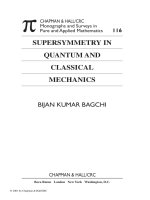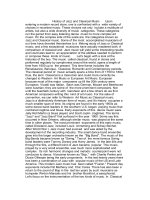jazz and classical music essay
Bạn đang xem bản rút gọn của tài liệu. Xem và tải ngay bản đầy đủ của tài liệu tại đây (36.04 KB, 5 trang )
Jazz and Classical Music
Upon entering a modern record store, one is confronted with a
wide variety of
choices in recorded music. These choices not only include a
multitude of artists,
but also a wide diversity of music categories. These categories
run the gamut
from easy listening dance music to more complex art music. On the
complex side
of the scale are the categories known as Jazz and Classical
music. Some of the
most accomplished musicians of our time have devoted themselves
to a life-long
study of Jazz or Classical music, and a few exceptional musicians
have actually
mastered both. A comparison of classical and Jazz music will
yield some
interesting results and could also lead to an appreciation of the
abilities
needed to perform or compose these kinds of music.
Let's begin with a look at the histories of the two. The music
called classical,
found in stores and performed regularly by symphonies around the
world, spans a
length of time from 1600 up to the present. This time frame
includes the
Renaissance, Baroque, Classical, Romantic and Contemporary
periods. The
classical period of music actually spans a time from of 1750 to
1800; thus, the
term Classical is a misnomer and could more correctly be changed
to Western Art
Music or European Art Music. European because most of the major
composers up
till the 20th century were European. Vivaldi was Italian, Bach
was German,
Mozart and Beethoven were Austrian; they are some of the more
prominent
composers. Not until the twentieth century with Gershwin and a
few others do we
find American composers writing this kind of art music. For the
sake of
convention, we can refer to Western Art Music as Classical music.
Jazz is a distinctively American form of music, and it's history
occupies a much
smaller span of time. Its origins are found in the early 1900s as
some dance
band leaders in the southern U.S. began playing music that
combined ragtime and
blues. Early exponents of this dance music were Jelly Roll Martin
(a blues
player) and Scott Joplin (ragtime). The terms "Jazz" and "Jazz
Band" first
surfaced in the year 1900. Some say this occurred in New Orleans,
although
similar music was played at the same time in other places. The
most prominent
exponents of this early music, called Dixieland Jazz, included
Louis Armstrong
and Sidney Bechet. After World War I, Jazz music had evolved and
was aided by
the development of the recording industry. The small dance band
ensemble grew
into the larger orchestra known as the "Big Band". The music of
the Big Bands
became known as "Swing." Two of the more famous Swing band
leaders were Tommy
Dorsey and Harry James. In the late 40s and through the 50s, a
different kind of
Jazz became popular. This music, played by a very small ensemble,
was much more
sophisticated and complex . Its rich harmonic changes and melodic
counterpoint
were not conducive to dance. It became known as "Bop," with
Charlie Parker and
Dizzie Gillespie being the early proponents. In the last twenty
years there has
been a combination of Jazz with popular music of the US and Latin
America. This
modern Jazz music has been called "Fusion." Present day exponents
include Pat
Metheny and Chic Corea. There has also been a return to the sound
of Bop in the
last ten years by such musicians as trumpeter Winton Marsalis and
his brother
Branford, a saxophonist.
Let's focus on the instrumentation of the two kinds of music. In
Classical music,
both large orchestras and small ensembles are used. But
generally, the greatest
and most prominent compositions are for the larger symphony
orchestra. The
largest part of the orchestra is the string section consisting of
violins,
violas, cellos and string basses. These instruments were invented
very early in
medieval times but really matured into their present form during
the late 18th
century. The wind instruments, comprised of brass and woodwinds,
took longer to
mature. The brass section in particular did not posses the
ability to play
chromatically (in all keys) until the advent of valves which
allowed the length
of the instrument to be changed while playing. This occurred
around the middle
to late 19th century. Consequently, the brass instruments are
less prominent in
the music of Bach, Mozart and Beethoven along with their
contemporaries. Late
19th and early 20th century composers make use of a very large
orchestra with
all the fully developed wind instruments. Some of the master
orchestrator/composers of this time were: Wagner,
Rimskey-Korsakov, Ravel and
Stravinsky. Currently, composers also make use of the full
orchestra but with
the addition of increasingly larger percussion sections which add
many unique
and unheard of sounds than in earlier music.
Early Jazz music was played in small ensembles making use of
clarinet, tuba,
cornet, baritone, drums, and piano. Dixieland groups of New
Orleans had similar
instrumentation. During the Swing era, larger groups were
employed to achieve
more of an orchestral sound. The Big Bands of the this era were
predominantly
wind orchestras containing alto and tenor sax sections, trumpet
and trombone
sections, along with piano and drums. When Bop music arrived, the
alto saxophone
and trumpet were the preferred instruments of the major soloists
who were backed
up by piano, string bass and drums. With the advent of Fusion,
electric
instruments such as the electric guitar and keyboard synthesizer
became
prominent.
How has each of these kinds of music been transmitted to later
generations of
musicians? Early in the evolution of classical music, a system of
notation was
gradually developed which for the most part remained stable from
the Renaissance
on. This gave the composer control over how his compositions were
to be played.
Throughout the history of Jazz, however, notation was more like a
rough sketch.
This was because the syncopated rhythms of ragtime and the
melodic riffs of the
blues were not easily notated. Also, early Jazz musicians were
not formally
trained; they usually learned by ear. Some songs were transcribed
and written
down, but not in precise ways. Jazz music became more of a passed
on tradition
that a musician learned through interaction with other players.
In a similar way,
the modern Jazz musician must rely on previous recordings to get
a feel for the
style and technique which he desires to learn from. But in
classical music, one
composer can learn from an older composer by looking at and
analyzing the music
that the previous composer wrote down. Likewise, classical
musicians can master
the parts they must play by practicing the music that has been
written or
published beforehand. These two approaches to passing on
tradition are both
valid. However, without the recording medium Jazz music might
have developed
much differently than it has.
The cohesive element that keeps a musical group together is also
an interesting
contrast. In Classical music, the conductor uses a baton and
plays the orchestra
as if it were his instrument; he looks at a complete score of all
the events
happening in the composition and interprets these events based on
his knowledge
and intuition of what the composer intended. Jazz groups rarely
utilize
conductors. The swing era employed them for the sake of keeping
the larger sized
group together but other jazz styles did not and do not to this
day. The drummer
of the Jazz ensemble provides the beat that keeps the group
together but even he
is interacting with the other soloists as the song is performed.
Perhaps the most interesting point of comparison between the two
types of music
is in improvisation. Improvisation is the ability to play and
compose
spontaneously "on the spot" while the music is playing. This has
been an
important element of Jazz from it's inception. Although
improvisation was less
prominent during the swing era, it regained importance with Bop
and onward.
Early Jazz was improvised, using ragtime and blues as a loose
structure. In the
swing era, popular songs were arranged by an arranger and
soloists played
improvisations over the repeating sections in order to lengthen
the song for
dancing. With the advent of Bop, improvisation assumed great
importance. The
musicians memorized the chord changes to a song, along with the
melody, but then
played very loosely and in the end substituted new chords along
with greatly
embellishing the original melody to the point of being
unrecognizable. These
factors, along with the ability to interact with each other,
became important
and remains so in the Fusion music of today.
In Classical music, modern listeners are mostly unaware of the
fact that many of
the great composers of the past were not only excellent
performers but also
great improvisers. Starting with J.S. Bach (1685-1750), the
greatest composer of
the Baroque era, he in fact made his living through his great
skill as an
improvisor. It was common for the Lutheran Church organist of his
day be able to
improvise on choral melodies and Bach was considered one of the
greatest at this.
There are written accounts of other composers improvisational
abilities
including Mozart (1756-1791), Beethoven (1770-1829), and Franz
Liszt (1811-1886).
Yet, as time went on, improvising gave way to the composer's
desire to exert
complete control over his music. By the late 19th century,
improvising was rare
and not used at all in public performances of classical music.
In summation, we can say that Jazz and Classical music represent
two approaches
to Art Music. The Classical composer or performer has a long and
rich body of
music in written form that he uses to learn from while the Jazz
musician uses a
body of recorded music to learn. Because of it's small size, the
modern Jazz
ensemble allows loose interaction while the symphony orchestra's
large size and
diversity of instruments provides many different sounds and wide
dynamic range.
In classical music the composer strives for control; he uses
printed music to
guide and direct the musicians through the conductor. In Jazz
music, the songs
are loosely composed, thus forming a basis for individual
expression within an
ensemble. When you go to hear a symphony, you hear an orchestra
conducted by the
conductor playing a composition. When you go to a Jazz club you
hear a small
jazz ensemble interacting and improvising a song. Both of these
kinds of music
provide rich expression and detail to the serious listener. They
take different
paths to reach their final form but give a person equal
opportunities to
appreciate the creative output of each.









